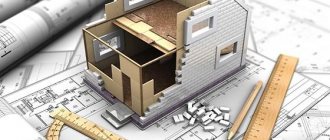Homeowners' property
According to Article 36 of the Housing Code of the Russian Federation, common property is considered to be that which is used to service two or more premises.
The common property of apartment building residents includes:
- elevators, corridors, staircases, basements and attics;
- premises allocated to meet social and domestic needs;
- engineering and technical equipment located both inside and outside the premises;
- roofs and technical fences;
- local area.
Reference! Over time, through the use of targeted contributions from citizens and non-members of the partnership, new objects of shared public property can be created in the apartment building, for example, a sports or children's playground. The decision to create a new property is made at a meeting of HOA members.
Responsibilities for maintaining common property
In order to fulfill the responsibilities for maintaining common property, property owners can become members of the HOA or must enter into an agreement with the homeowners’ association, on the basis of which the organization is delegated all rights to carry out such actions.
The agreement states that the financial burden for maintaining the common property lies with the owners, regardless of their membership in the HOA, in proportion to the share of ownership.
Citizens who are not members of the partnership are charged only for the maintenance of the property. Non-members of the HOA are not required to pay bills for the purchase of new property or additional services, for example, security of a yard or parking lot.
The amount of payment is determined by the income/expense estimate, which is approved at the general meeting. According to the Rules adopted by the Government of the Russian Federation No. 491, the amount of regular payments is determined by the general meeting and is mandatory for everyone.
In the field of maintenance of common property, the HOA carries out the following work:
- represents the interests of owners;
- carries out work within the framework of the charter;
- concludes contracts with maintenance and repair organizations;
- controls the implementation of the clauses specified in the concluded contracts;
- selects service and resource companies;
- accepts contributions and payments for utilities;
- transfers funds under contracts;
- makes mandatory payments;
- determines the estimate and regularity of payments by owners;
- requires timely payment;
- carries out general property insurance.
Maintenance of common property: what does it include?
According to Article 151 of the Housing Code of the Russian Federation, the property of the partnership itself is movable and immovable property located inside and outside the house:
- premises for servicing the activities of the HOA;
- inventory;
- office equipment;
- furniture;
- consumables, the use of which is mandatory for the performance of the tasks provided for in the charter.
The HOA has the right to acquire property at the expense of membership fees if such acquisition is carried out to achieve the statutory goals of the organization.
Note! The partnership does not have the ability to alienate, and, therefore, acquire shared property. However, by decision of the general meeting, such property may be transferred to the partnership for use.
Any acquisition of new movable property by the HOA is recorded in accounting entries and has documentary support and confirmation (check, agreement, etc.). Ownership of real estate is registered in the relevant title documents, where the owner is designated as a partnership.
The HOA may acquire at its disposal the property that belonged to the owners, but for use for purposes other than residence. For example, these could be various non-residential premises on the ground floor, which were used for arranging shops, pharmacies, studios, etc.
The maintenance and acquisition of property of the partnership is carried out at the expense of membership fees of home owners. With these funds, the HOA has the right to purchase anything that is directly related to achieving the goals specified in the charter. These funds also pay salaries to the administration and service personnel.
Board room
The premises in which the board and maintenance personnel carry out their work may be allocated from part of the shared ownership. This decision is made by all owners. An area in the corridor, basement, on the technical floor can be allocated, or a separate room in the house can be purchased at the expense of members of the HOA.
The premises must have access to electrical and heating networks, means for storing documentation (contracts, accounting reports), and, provided there is a cash register for accepting contributions and payments, a security system.
How to conclude an agreement with a management company, HOA, housing cooperative, between owners?
First of all, the owner needs to enter into a written agreement with organizations involved in the supply of resources (water, gas, electricity, etc.). And also with organizations for the removal of solid municipal waste.
Next, you must provide the management company with:
- copies of contracts, within 5 days after conclusion;
- information on the volume of resources expended;
- information on the volume of solid waste removal services within 3 days.
The duration of the agreement with the management company is from 1 to 5 years. If during this period there are no violations of the terms of the agreement between the owner and the company, then the document is renewed automatically.
If the owner of non-residential real estate has not concluded an individual agreement with the RSO, then he will pay for services at the same rate as all owners of residential premises.
When joining an HOA, the following points are indicated in the document:
- list of property transferred for maintenance;
- work that may be needed for repairs;
- liability of the HOA for failure to fulfill its obligations;
- owner's obligation to pay for utilities;
- terms, procedure and amount of payment for utility services.
The housing cooperative must have a constituent document, which will indicate:
- name of the cooperative;
- its location;
- purpose of activity;
- how to join a cooperative;
- how to get out of it and the conditions for receiving your contribution back;
- contribution schedule;
- liability for non-compliance with the terms of the contract;
- bodies that control the activities of housing cooperatives;
- bankruptcy and liquidation of housing cooperatives.
As for the agreement with the housing cooperative, it will look the same as with the HOA. But not only the owner of the premises, but any person or organization that has made a contribution can become a member of the cooperative. The document is drawn up in two copies. Upon termination of the contract, the owner’s responsibilities include concluding a similar contract with another organization.
Operational management of real estate will come into force after contacting Rosreestr to register the fact of transfer of rights. The period for registration of rights is 7 working days. If the transaction is made on the basis of notarized documents, the registration period will be reduced to 4 days.
The state fee for registration of rights has been established in the amount of 22 thousand rubles for organizations and 2 thousand rubles for individuals (Article No. 333.33 of the Tax Code of the Russian Federation).
With a small number of owners, they can independently manage the property. With this method of management, several owners, by decision of the general meeting, select organizations to provide services and maintain the building. Agreements with RSO are concluded by each owner in his own name. If relations with third parties are necessary, one of them or another person entrusted with these powers may act on behalf of the owners.
Form and content
There is no special form of agreement for owners of non-residential real estate; it will be the same as for owners of residential premises and the same for all management organizations. The main points of the agreement will be:
- subject of the contract;
- rights and obligations of the parties;
- cost of utilities;
- payment order;
- liability of the parties;
- validity period of the document;
- termination procedure;
- additions;
- addresses, details and signatures of the parties.
This is important to know: Exiting the HOA of an apartment building: procedure
The procedure is considered completed after state registration, and the agreement comes into force.
Amendments to the contract
You can make changes to an already concluded and registered agreement in several cases:
- If there was a violation of the terms of the contract by one of the parties. In this case, changes can be made unilaterally only through the court (Article No. 162 of the Housing Code of the Russian Federation).
- By agreement of both parties.
Also, the contract can be changed if a law has been adopted establishing new rules for the parties that the concluded contract did not take into account.
Relations between the owners of non-residential premises and the partnership
The complexity of the relationship between HOAs and owners of non-residential premises lies in some contradictions contained in regulations.
On the one hand, the Housing Code defines the right of shared ownership of non-residential premises. On the other hand, the Decree of the Armed Forces of the Russian Federation N3020-1 “On the delimitation of state property” of 1991, the Decree of the President of the Russian Federation No. 2284 of December 24, 1993, and the Decree of the President of the Russian Federation No. 1535 of July 22, 1994, states that such the premises are transferred to the ownership of the locality administration and can be privatized.
Often, such premises cannot be separated from common property , since they often contain communications and engineering equipment, the work of which is aimed at servicing the house. Closing free access to them for routine or emergency work may become the subject of a dispute between the HOA and the owner.
Many questions also arise about the participation of owners of non-residential premises in the general costs of its maintenance. In this case, the owner of the non-residential premises must sign an agreement with the HOA for the right to share participation in use and expenses or for the management of common property.
The Housing Code in this sense obliges all owners of both residential and non-residential premises, regardless of whether they use common property or not, to bear an equal burden for the maintenance of real estate.
Reference! The amount of payment for the maintenance of common property may be established at a general meeting. It can be either proportional to the share of each owner, or have an increasing coefficient in relation to owners of non-residential premises.
Conclusion of an agreement
The agreement between the HOA and the owner of the non-residential premises has a form slightly different from that concluded between the partnership and the owner of the residential premises who is not a member of the HOA.
The contract must contain the following mandatory clauses:
- transfer of property in common shared ownership;
- list of services provided aimed at maintaining common property;
- determining the cost of maintaining a house.
The contract should clearly indicate the following points:
- Procedure for access to engineering and communications equipment for inspection and repair.
- Possibility of taking readings from meters.
- The right to use common property.
- Distribution of responsibility for the care of land near non-residential premises.
Important! A separate agreement between the parties is drawn up for the supply of utilities, since it is difficult for suppliers to separate one premises from another and it is easier to have one consumer in the person of the HOA.
How do HOAs and owners of residential and non-residential premises interact?
Increasingly, residents of apartment buildings are organizing homeowners' associations. In this regard, the question arises whether it is necessary to become a member of such a community. First of all, you need to understand how owners interact with the HOA.
How is the HOA related to the owners of the premises?
A homeowners' association is created by the owners of the premises of an apartment building in order to independently manage the common property. According to Article 136 of the Housing Code of the Russian Federation, such a non-profit organization can be created only with the consent of at least half of the owners of apartment buildings.
Due to the fact that the HOA independently manages the building in the housing and communal services sector, residents can rationally use funds to improve their living conditions. The Partnership performs a number of functions, such as:
- use of common property of one or more apartment buildings;
- creation of special funds to raise funds for home repairs;
- carrying out activities aimed at beautifying the apartment building and the surrounding area;
- collection of funds from residents as payment for utility services provided to them, as well as various types of voluntary contributions;
- concluding relevant agreements with resource supply organizations;
- provision of utilities to residents of apartment buildings;
- maintaining records of all income and expenses of the organization.
The list of functions that the community performs does not end there. The HOA carries out many more actions aimed at improving the living conditions of citizens.
Homeowners have the right to independently decide whether to join an HOA or not. In addition, they can:
- elect the board of the community and its chairman by election;
- participate in the activities of the organization, making decisions at meetings;
- control the financial activities of the partnership;
- make voluntary and mandatory membership fees;
- leave the community membership at your own request based on an application.
In other words, premises owners can take an active part in the partnership for the improvement of their home and surrounding area.
How does the HOA and property owners interact?
HOAs can include both residential and non-residential premises. In both the first and second cases, the organization interacts with their owners.
Non-residential premises
Non-residential premises are defined as independent objects. However, they cannot generally be separated from common property. Owners can become members of the community if they wish.
Owners who are not members of the community enter into an agreement with it, which stipulates the owner’s share in the common property and the costs of its maintenance.
Payment for the maintenance of common property for owners of non-residential premises is calculated in the same way as for apartment owners.
Note! The agreement is signed in order to prevent problems with access to non-residential premises. Most often these include attics and basements, where communications and equipment may be located.
But by law they have autonomous status.
Because of this, HOAs may have problems with access to communications necessary for the life support of the entire apartment building if they are located in premises that are owned by a private individual.
Living spaces
Legislatively, there is no difference in the statuses of residential and non-residential premises included in the common property of an apartment building. The procedure for interaction between the partnership and the owners depends on whether they are its members or not.
Thus, HOA members are considered as individuals who are part of a non-profit organization. In turn, appropriate agreements are concluded with people who do not want to enter into a partnership. Both categories have specific rights and responsibilities.
For example, the maintenance of common property is the responsibility of both community members and people with whom agreements are concluded.
Rights and obligations of premises owners in relation to the HOA
Each owner of an apartment building managed by a partnership has specific rights and obligations.
How to register non-residential premises as the property of the HOA?
As already mentioned, a partnership can act as the owner of real estate, including non-residential premises, but only if it acquired them as a result of an act of donation, purchase, and similar actions described by the Civil Code of the Russian Federation.
How can an HOA become the owner of common property, even if it is non-residential? In this case, only a meeting of all owners of shared property can make a decision on the sale of this property to the HOA. All relations between owners, regardless of their participation in the HOA, are regulated by federal laws, the Housing Code and Government Decrees.
To avoid friction and lawsuits, any transactions by the HOA must be carried out with the approval of the owners. Relations with the owners of non-residential premises are established on the basis of concluded agreements for the provision of utility services and participation in the maintenance of common property.
What is management of non-residential premises and how to conclude an agreement?
Often the issue of transferring rights to manage real estate is very acute. This is especially true for owners of several premises. In order to simplify management and shift part of the obligations to third parties, there is the right to operationally manage real estate. To choose an effective management method, it is necessary to study the existing ones, their features and nuances.
This is important to know: Responsibilities of the chairman of the housing cooperative in apartment buildings
Dear readers! Our articles talk about typical ways to resolve legal issues, but each case is unique.








